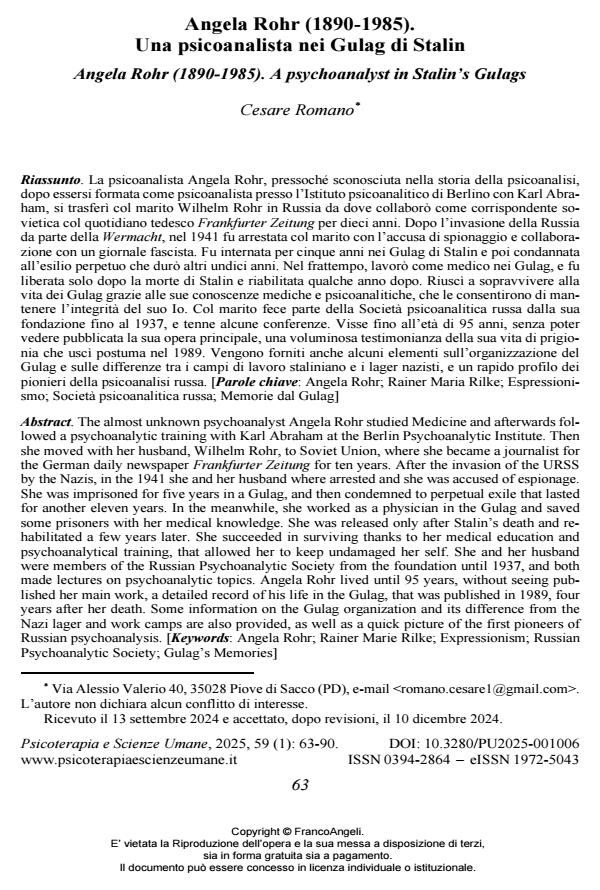Angela Rohr (1890-1985). A psychoanalyst in Stalin’s Gulags
Journal title PSICOTERAPIA E SCIENZE UMANE
Author/s Cesare Romano
Publishing Year 2025 Issue 2025/1
Language Italian Pages 28 P. 63-90 File size 628 KB
DOI 10.3280/PU2025-001006
DOI is like a bar code for intellectual property: to have more infomation
click here
Below, you can see the article first page
If you want to buy this article in PDF format, you can do it, following the instructions to buy download credits

FrancoAngeli is member of Publishers International Linking Association, Inc (PILA), a not-for-profit association which run the CrossRef service enabling links to and from online scholarly content.
The almost unknown psychoanalyst Angela Rohr studied Medicine and afterwards followed a psychoanalytic training with Karl Abraham at the Berlin Psychoanalytic Institute. Then she moved with her husband, Wilhelm Rohr, to Soviet Union, where she became a journalist for the German daily newspaper Frankfurter Zeitung for ten years. After the invasion of the URSS by the Nazis, in the 1941 she and her husband where arrested and she was accused of espionage. She was imprisoned for five years in a Gulag, and then condemned to perpetual exile that lasted for another eleven years. In the meanwhile, she worked as a physician in the Gulag and saved some prisoners with her medical knowledge. She was released only after Stalin’s death and rehabilitated a few years later. She succeeded in surviving thanks to her medical education and psychoanalytical training, that allowed her to keep undamaged her self. She and her husband were members of the Russian Psychoanalytic Society from the foundation until 1937, and both made lectures on psychoanalytic topics. Angela Rohr lived until 95 years, without seeing published her main work, a detailed record of his life in the Gulag, that was published in 1989, four years after her death. Some information on the Gulag organization and its difference from the Nazi lager and work camps are also provided, as well as a quick picture of the first pioneers of Russian psychoanalysis.
Keywords: Angela Rohr; Rainer Marie Rilke; Expressionism; Russian Psychoanalytic Society; Gulag’s Memories
Cesare Romano, Angela Rohr (1890-1985). Una psicoanalista nei Gulag di Stalin in "PSICOTERAPIA E SCIENZE UMANE" 1/2025, pp 63-90, DOI: 10.3280/PU2025-001006